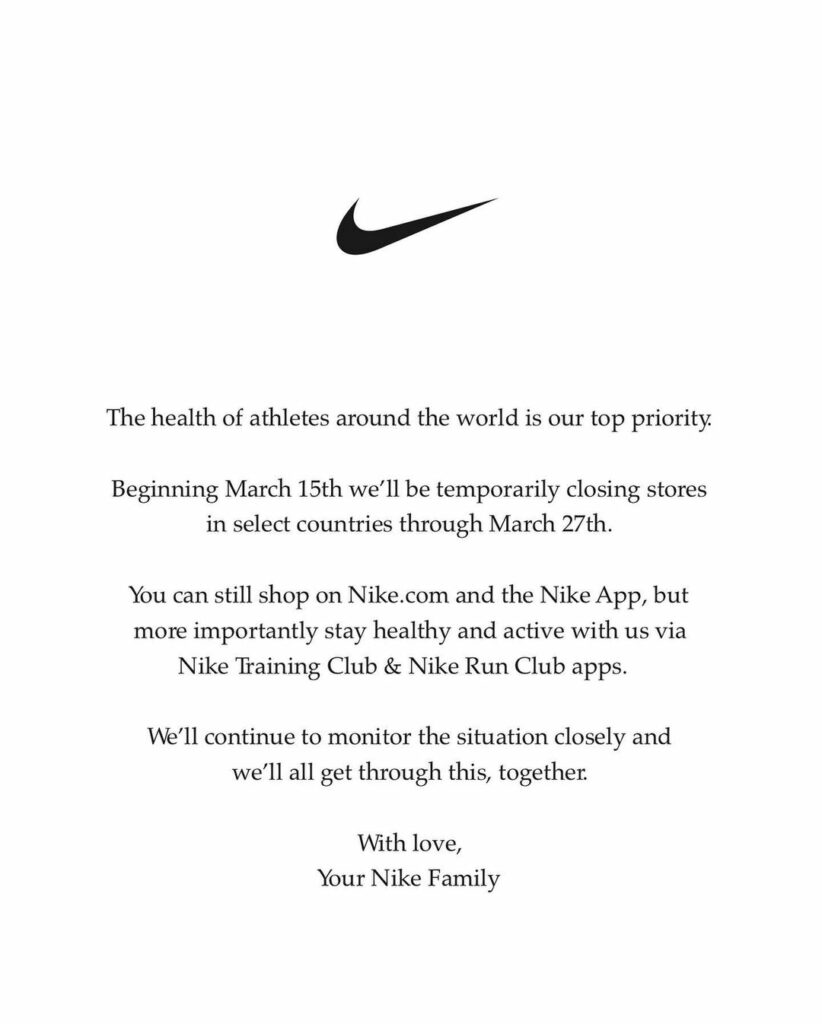Nike is focusing on the brand’s digital training platforms, specifically Nike Training Club and Nike Run Club
Photo by Thomas Serer/Unsplash
The COVID-19 crisis has challenged many brands like Nike to make necessary adjustments in their business plans. And the American corporation is doing it through a four-step business plan that involves its e-commerce and supply-chain expertise.
According to Nike CEO John Donahoe, the sporting goods manufacturer will follow the corresponding steps: containment, recovery, normalization, and return to growth. These were the exact same steps Nike pursued when the crisis first happened in China. In January, Nike reported that more than 5,000 stores closed down in China alone coupled with a five percent decrease in sales, including in Hong Kong and Taiwan.
The COVID-19 crisis is the first major challenge of Donahoe who just started his tenure in January. Donahoe told Wall Street Analysis that the first step the brand did was to provide digital service to consumers, especially those who will be spending a lot of time indoors.

“Stores were closed, but the e-commerce growth in all three markets remained strong during that time,” says Donahoe in an investor conference call. “The strong engagement of Chinese consumers with our activity apps translated into strong engagement with our Nike commerce app,” he adds.
Nike then shifted its focus to the brand’s training apps, specifically Nike Training Club (NTC) and Nike Run Club. NTC, a home workout app, saw an 80 percent increase in weekly users. Both platforms were linked to Nike’s e-commerce sites where digitals sales increased 30 percent across China, Taiwan, Hong Kong, and Macau.
“The strong engagement of Chinese consumers with our activity apps translated into strong engagement with our Nike commerce app,” says Nike CEO John Donahoe
Now that the pandemic has impacted North America and Europe (which together generates 67 percent of Nike’s revenue), Donahoe says Nike will implement the same four phases it did in China:
First step: Containment
The company is maximizing its virtual training apps by waiving fees for the premium version of NTC. Aside from the features in the free version, users can also access on-demand workouts and tips from trainers for 90 days.
Step two: Recovery
As of Apr.1, 80 percent of its 7,000 stores have resumed operations in China, including in Wuhan where the outbreak first started. Nike did this by gradually reopening its stores based on customer health per city. “Consumers are back on the streets and we’re seeing retail traffic come back. Consumers are in the stores. They’re engaged, they are often wearing face masks, but they’re back on the street,” says Donahoe.

Step three: Normalization
In this phase, stores will begin operating like they did before the outbreak. Since this phase was implemented in China, Nike’s shares shot up by 10 percent in the trade industry. “Our digital business in China has accelerated even further over the past months and we are now seeing double-digit increases in retail traffic week over week, with some stores having already returned to prior-year levels,” Donahoe says.
Step four: Return to growth
The final stage is about regaining momentum. Before the coronavirus spread and infected the majority of the world, Nike’s stocks grew 32 percent. Donahoe says that Nike aims to build more powerful online and offline experiences and regain its positions in cities like New York, London, and Shanghai. “We know in times like these that strong brands get even stronger. No one is better equipped than Nike to navigate the current climate,” says Donahoe.